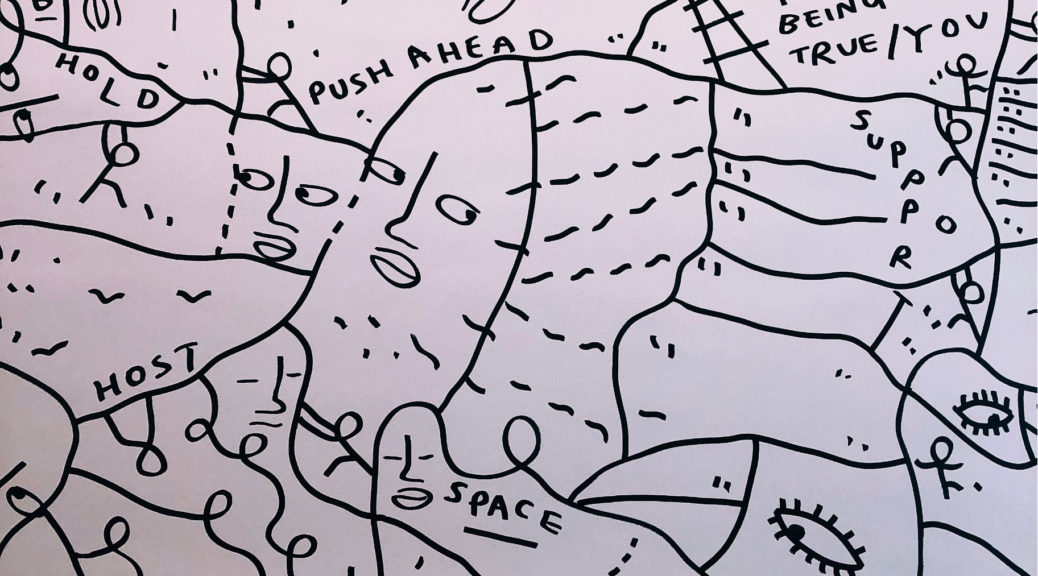Diagrams and Maps in Cognitive Analytic Therapy
“The map’s up here up here, it’s in my head. . . the map is like a
map of a tube station and you know where all the tubes are, and you don’t need to erm go and have a look and see which line you need to go on or whatever because I know and that’s why I don’t need to look at the map anymore.”
During cognitive analytic therapy (CAT), the therapist makes drawings, doodles and diagrams as you tell your story and describe what brought you into therapy. This will usually take place during your early meetings, and throughout a number of sessions.
Your therapist will usually make drawings on paper on a table or other surface between you, so that you can both see them. Your therapist will check out with you whether what they are sketching makes sense to you. This is all part of the process of collaboration. Your therapist tries to work alongside you, being curious, checking out your thoughts, and whether they have understood you correctly.
The following sections aim to answer common questions about maps and diagrams in cognitive analytic therapy. Click on each one to visit that section.
Why use diagrams in CAT?
What’s the difference between CAT maps and CAT letters?
When are maps made?
What will my map look like?
So what is included in a CAT diagram?
Does it have to be all about problems?
What if looking at all of this at once feels too much?
What if I struggle with reading?
Is the diagram mine to keep?
Can I make my own version of a map?
Can I have an electronic version of my map?
What about when I make changes?
Why use diagrams in CAT?
The purpose of creating a diagram together in CAT is to give you and your therapist a brief visual way to understand and describe repeating cycles you get stuck in. This is like building a map of the emotional “territory” you live with. It can help you both to work out where you are on this emotional map, as you talk about what’s come up between sessions.
Sometimes these same patterns come into play between you and your therapist during sessions. The map can help you work out where you both are in this emotional landscape. It can be especially helpful if strong feelings arise in sessions.
For example, you might have a habit of going along with what you think other people want, because in the past important people in your life have been very angry or punishing if you have not. You or your therapist might notice you feeling very anxious and apologising a lot for not managing to do something you said you’d do at the last session. Together you might use the map to spot this pattern, and link your anxious feelings to the expectation that the therapist will be cross with you.
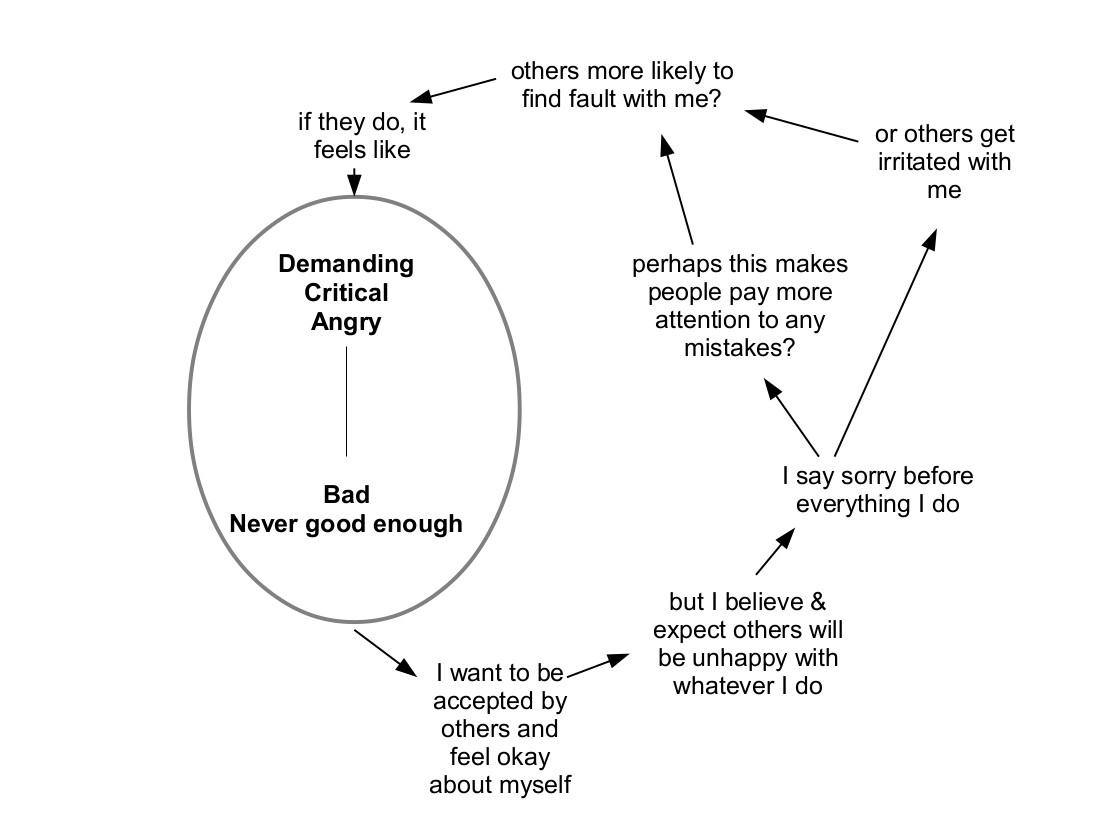
CAT pays a lot of attention to finding accurate descriptions of problem patterns, thoughts and feelings together. Describing them accurately, in ways that make sense to you both, is important as you go on to make changes.
Because a map can simplify complex patterns, it is also helpful when you are exploring how to change and find ways out of repeating patterns. It can help you find paths to a new destination, rather than arriving back in the same old place, time and time again.
What’s the difference between CAT maps and CAT letters?
In CAT therapy of sixteen sessions or more, your therapist usually writes a letter to you after the early sessions, to help pull together themes and patterns in a written form. You can read more about this in our blog article Stages on a CAT Therapy Journey – click here to read this blog.
The diagram is a visual way of summarising the content of the letter. It acts as a short-hand way of describing and illustrating the main areas of focus in your therapy.
People can get different things out of the letter and the diagram. Some prefer one more than the other. Even if you don’t find the map very useful, it will help your therapist keep your story, relationship roles, and patterns in their mind as you work together.
When are maps made?
Your therapist may start sketching out cycles and relationship roles from you first meeting and over the course of the early sessions. They may draw out a more complete and neat map around the time they offer you a reformulation letter. This is likely to bring together various smaller diagrams that haven’t been clearly connected in earlier sessions.
CAT therapists mainly aim to put this bigger map together with you during a session. Sometimes your therapist will draft something like this before your session. In any case you will have a chance to talk it through together to make sure that it makes sense and describes things in a way that feels accurate to you. If it doesn’t make sense then together you and your therapist can change it so that it’s more useful.
What will my map look like?
There are no hard and fast rules to making maps and diagrams in CAT. Some CAT therapists work more from templates that they find useful to help structure what they draw. However what goes into each map is very individual. Each therapist will have their own preferred style, and each map will also differ according to the person in therapy. Important elements of your own story will shape your map and it won’t be the same as anyone else’s.
It will usually include brief words with arrows connecting them. Some therapists use pictures too. A map might remain in a hand-written form, and some may be typed up to make them easier to read. If you have a preference for one or the other, you can tell your therapist and they will try to make a map that suits your needs.
You’ll see lots of examples of different styles of maps throughout this website.
So what is included in a CAT diagram?
Relationship roles
Your diagram will reflect important influences on you throughout your life that have shaped how you relate to yourself and to others. These may include:
-
family and other important early relationships
-
your social world, including your peers at different points in your life
-
messages from your culture as you grew up, and
-
communities and social circles you live in now
Important relationship roles (known as reciprocal roles in CAT) may be represented as ovals containing words or pictures. Read more about relationship roles by clicking on this link.

Unmanageable feelings or states of mind
You diagram is likely to include strong feelings that you have, or difficult states of mind that you get into. These may be placed as words within a rectangle, another shape, or perhaps given a colour. Some people describe such states of mind using a particular metaphor. For example, feeling very depressed might be described in words as a “pit” or “cave”. Or you might have described feeling very stressed, worked up and rushing as “rat on roller skates”. Sometimes pictures are used too.
Repeating patterns
The diagram will include loops or sequences of patterns that keep you feeling stuck. These will be plotted using words or pictures, connected by arrows. The sequences are based on:
-
what you’ve described and discussed in early sessions
-
what’s come up between you and your therapist so far, and
-
information from the Psychotherapy File and other written forms
There may be three or four patterns and sometimes they will overlap with each other. Patterns may be colour-coded to help separate them.
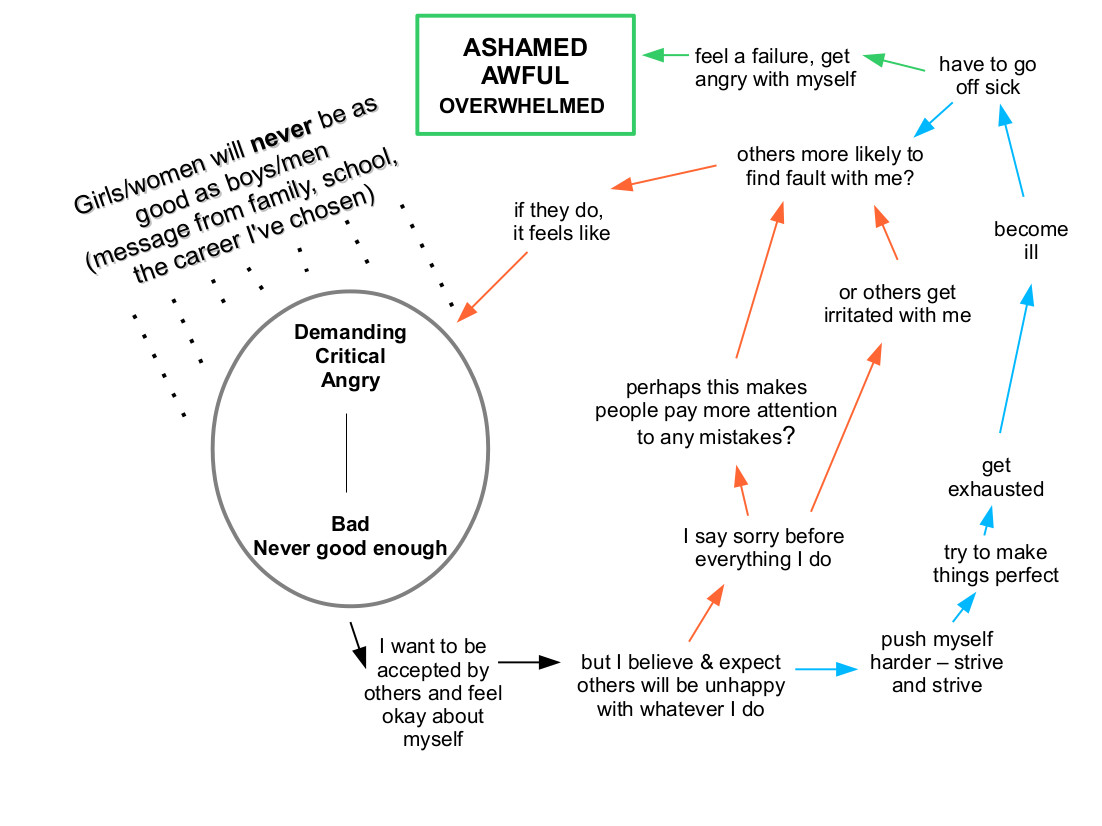
Observing eye
Some diagrams include a picture of an eye, which is a way of describing your ability to observe what you are feeling, thinking or doing. Read more about the idea of the “observing eye” in CAT by clicking here.
Back up
Does it have to be all about problems?
While CAT aims to help you overcome patterns that cause you problems, or manage them differently, your therapist will also pay attention to strengths and positive resources. Healthy and helpful ways of relating and coping may be marked on the map too. These are sometimes referred to as your “healthy island“. Another way to ensure these positive aspects are kept in mind is to create a strengths map alongside this problem-focussed map during the early sessions.
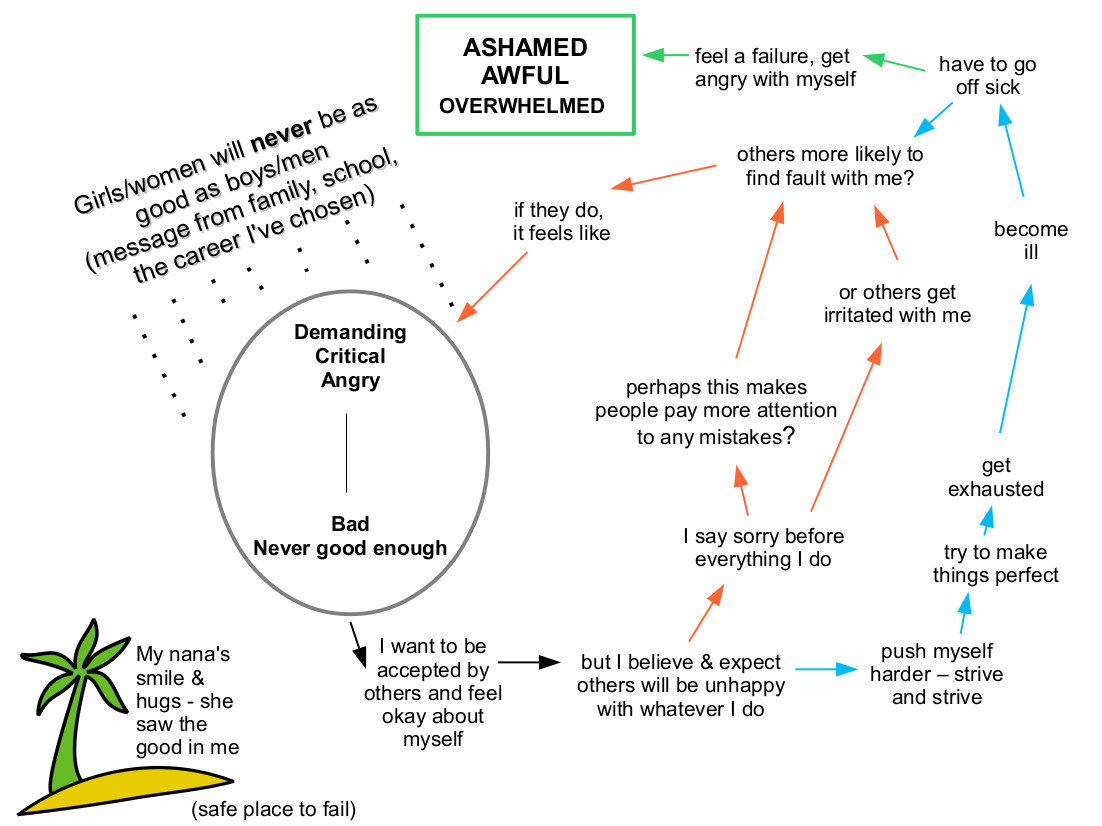
What if looking at all of this at once feels too much?
Sometimes it can feel really helpful to have a map which brings together several aspects of your experience in a way that is understandable and useful. People often feel confused and overwhelmed by their psychological difficulties and a map can give some clarity and relief. Some people describe it as helping them put together different pieces of a jigsaw that haven’t made a big picture before.
However, some people people can find it more manageable to look at just one cycle or pattern at a time. Looking at several put together on one map can feel a bit overwhelming. This is especially the case if you have coped with difficult emotions or trauma by keeping things at a distance, cut off or “compartmentalised”.
If it feels too much to look at it all together, your therapist will be happy to keep things in smaller chunks or cover up parts of the map. They might put a bigger map away for the rest of the therapy, or until you feel more able to manage it.
If you have any concerns about this, do feel free to raise them with your therapist in the early sessions, or at any other time during therapy.
What if I struggle with reading?
If written words are not easy for you, the map may include more images and pictures. Some maps include no words at all.
Maps can be adapted in different ways if you have particular needs such as if:
-
you’re not a confident reader
-
a condition like dyslexia, autism or a learning disability makes using complex written information difficult
-
you have sensory impairments
-
you and your therapist speak different languages
Is the diagram mine to keep?
Yes of course. The map is created with and for you, and is yours to keep. Your therapist will keep a copy too. You can refer to it whenever you want and your therapist will invite you to do so regularly. You might look at it more often during therapy, but the diagram can also be useful later on, after therapy has ended.
Keeping a small version close at hand, or somewhere you can find easily at home, can be helpful. Some people like to have a picture of it on their mobile phone to carry wherever they go.
Can I make my own version of a map?
Of course there’s nothing to stop you making a version of a diagram that makes more sense to you on your own terms, or expresses your experience in a way that is different from the typical CAT approach. This is where CAT can invite you to be playful and creative. Some people adapt their own maps using approaches or technology they’re familiar with – in this way they help to educate their therapist.
If you do make big changes to your map it will help if you can discuss these with your therapist and let them keep a copy too. It will help your therapy if you can both work from the same material.
Can I have an electronic version of my map?
If you’re in CAT therapy through an NHS service it may not be possible to have an electronic version, due to concerns about confidentiality. Each Trust will have its own data security policy but generally NHS Trusts are reluctant to transfer sensitive information by email and will never do so by memory stick/USB.
If you are in CAT therapy on a private basis, it may be easier to get an electronic copy of your map. To comply with data protection laws, your therapist will take care about how this is transferred to you safely, securely, and in a way that protects your privacy.
What about when I make changes?
CAT therapy encourages you to explore possibilities for change. As you start to imagine or try out ways of doing things differently, you and your therapist can add these to your map. If you feel unsure about making marks on your map, you can use a photocopy or perhaps mark changes on tracing paper over the original.
By the end of the therapy, your map might look quite different. Changes may be marked in a different colour, with different arrows pointing to changes you’ve made. In CAT these are known as exits, and may be marked with a symbol like the letter “E”. Sometimes a new ending diagram will be created, which includes these changes and exits
The ending map might also include new relationship roles that have developed. For example you may have found ways to be more kind, fair, or accepting to yourself. Or there may have been something about how the therapist has understood you, listened to you or kept you in mind that you feel you can add to your map as something to take away for the future. Your healthy island may have grown and this might be highlighted on your ending map.
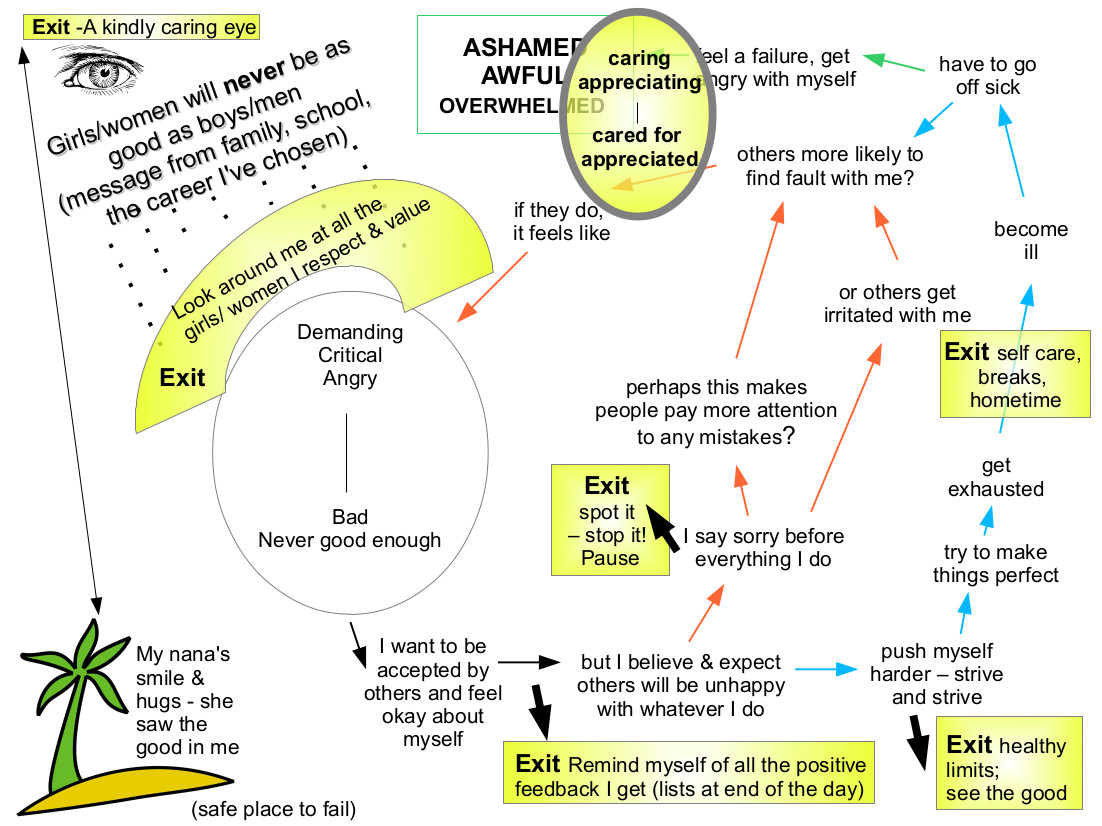
If you’ve not used the diagram much, it may not feature strongly in your ending sessions. However your therapist will still include any changes in written form in the ending letter they will share with you.
You’ll be invited to think about any changes that have come about and write an ending letter to your therapist too. The map might be helpful at that stage too, as you consider what’s different now, compared to when you started therapy.
Diagrams and Maps in Cognitive Analytic Therapy by ACAT Public Engagement Team
CC BY-SA 4.0
